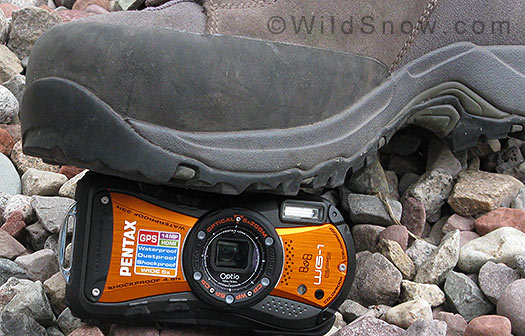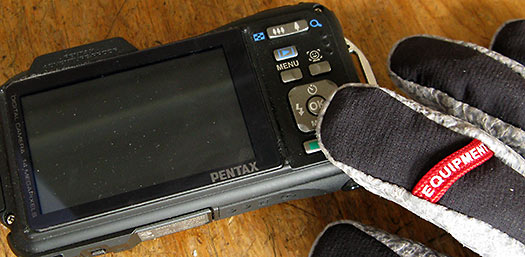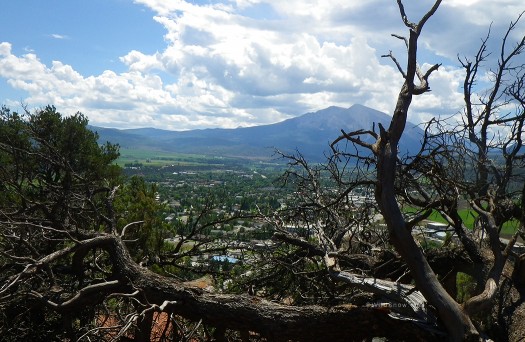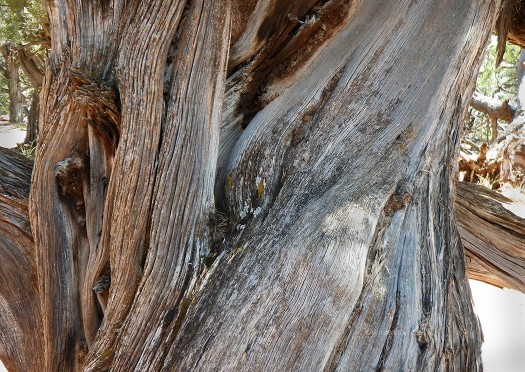Observing the camera business is like watching a ducky derby drop Niagra Falls.
It appears more like a game of chance on the random waterfall of consumerism, rather than any sort of logical effort to make good cameras. Then along come smart phones with good built-in cameras; good rapidly getting better; most accepting cool photography apps and so forth. Indeed, I’m seeing an almost uncanny shift towards casual photography being taken over by “devices” other than dedicated cameras. The change is happening fast.

Step on it or dunk it, you'll still get your hero shots. Pentax Optio WG-1 GPS toughcam.
Thus, point and shoot camera makers should be scared. Very scared. (Or they should just build cameras that the user can install software mods and apps on.)
Apparently, the camera makers if not scared are at least concerned. Result: featuritis. But are features such as microscopic shooting and smile recognition any match for what you can do with apps and a smartphone? Is the featuritis disorder a terminal disease?
Consider the Pentax Optio WG-1 camera with GPS “toughcam.” Most smartphones are relatively fragile. Optio is so waterproof you could probably dive with it, and it drop tests about 5 feet onto plywood. Cool, you say, perfect for backcountry sports (and way better than smashing the stuffing out of my iPhone).
In my testing, I could get adequate static shots of any sort out of the WG-1, so we can easily say you’d be happy with this camera for sports such as rock climbing, or photographing scenics during the uphill portion of ski touring. But what about shooting ski action, in dramatic tight shot style (any camera, any smartphone for that matter, can shot big loose shots with tiny skiers)?
First, know the Optio continuous shooting modes won’t do much to help you with shooting backcountry skiing action. Continues mode with WG-1 yields about one frame per 1.38 seconds, while my old standby P&S does one frame per second. One photo per second is marginally adequate for continuous shooting of a skier (some would say it’s not acceptable), so I’m less than thrilled about the Optio being slower than that. And without an optical viewfinder to help you watch what your capturing as you track a skier, machine gun photography is somewhat of a joke for capturing skiing anyhow, unless you’re awfully good at guessing where the skier is in the frame.
Saving grace is that if you set WG-1 toughcam to burst mode, it will machine gun 19 frames in just about 8 seconds. Only when doing so, the LCD will be blacked out so you’ll have no idea if the burst is pointed at anything (unless your shot is easily pre-composed, such as shooting a skier coming through a snow pile directly at you.)
Another challenge in doing ski photography with this sort of rig: As Optio WG-1 has no way of controlling shutter speed (on other cameras, TV or Manual modes), you’ll get blurred ski shots unless you fiddle around quite a bit to get the shutter speed up. I did so by adjusting ISO and brightness settings while in “P” mode, till I saw adequate shutter speed shown in LCD (generally, 500th of a second or faster).
To be fair, WG-1 does have a “Sports” mode that attempts to set a high shutter speed, along with doing follow focus. I tested by photographing cars moving on the street and could not get the follow focus to do anything but bounce around the LCD in what appeared to be an almost random fashion. Perhaps I’m missing something, but I’d suggest not depending on the Optio “Sports” mode to supply action ski shots. Besides, the camera does have a snow photo mode that probably helps make winter-scapes look nicer, but when you’re in “Sports” mode you are switched out of Snow mode.
Considering all above, what will probably work best for photographing backcountry skiing action with this cam is to tweak your ISO and brightness in “P” mode till you see a high enough shutter speed displayed in the LCD. Along with that you’d be watching the live histogram (a graph that shows a no-lie rendition of your exposure) on the LCD to be sure your snow tones will be at least salvageable in your photo software. (All this because the camera doesn’t have manual settings…sigh… it could be so easy.) Incidentally, I tested the LCD in direct sunlight and legibility is quite good. You’ll still have trouble seeing LCD information in bright sun at altitude in snowy environments, but by playing around with your sunglasses while shading the camera you can make it work. If you already use a camera without optical viewfinder (most P&S cams and smartphones) you’re already used to dealing with this.

No modern camera is glove friendly, but some are better than others. We'd rate the Optio as below average in gloved finger control due to the tiny and closely spaced buttons. That said, please know plenty of other cameras are tougher to operate with gloves -- some nearly impossible in backcountry skiing conditions. The upper button is the zoom control, which thankfully is spaced a bit apart from the other controls, so it can be pressed with thin gloves without accidentally switching something.
Durability is the Optio’s best feature, but the GPS is definitely useful (though a yawner for smartphone users, who’ve had GPS or faux GPS in their phones forever). You can set this so the meta data (confusing, see more below) for your photos includes GPS cords, and also have the camera log a GPS track that’s saved as a KML file you can easily use in Google Earth or elsewhere. Cords are GPS datum WGS84 and are unfortunately displayed as degrees, minutes, seconds rather than decimal.
Sidebar: Megapixel madness. Don’t get trapped into rating a camera by its megapixel count. Optio WG-1 grabs 14 MP at largest size setting, yielding a photo that’s 4,288 pixels wide. In theory, at 300 pixels per inch (rule of thumb for paper printing) that’ll yield a 14 inch wide paper print or double magazine spread. But don’t get your hopes up. Megapixel count is only part of the equation. Basic quality of the image plays a huge role in how prints look. From what I see in Photoshop when looking at my Optio test shots, I’d say that for something worth viewing you’d only want to print from this camera at a max of around 10 inches wide (usually, an 8×10 or thereabouts). Also, I’ve got another camera kicking around that’s known for quality, but only shoots 8 megapixels. I played around with images from both cameras, and by the time I was done you couldn’t tell the difference between the two.
More about the WG-1 GPS function. When set to do so, the built-in GPS stamps your photos with GPS cords, and also optionally creates a cord log as a Google Earth compatible KML file. The GPS function seemed to work fine, with one annoying and potentially frustrating aspect: If you turn on logging, it will continue logging even with the camera turned OFF until the battery goes dead. I guess the idea with this is you can log your trip continuously. Bummer is if you want to do some logging, you’ll have to remember to turn the logging function off every time you shut off the camera. Talk about any annoyance. Better, just carry a stand-along GPS with good battery life to record your trips, and only use the Optio GPS function to stamp your photos.
The GPS marking/stamping is somewhat confusing and I’m actually not sure I’ve got it figured out. But here is my latest take on the details. Beyond setting the camera to write an image of the GPS cords directly on your photo (not desirable unless you’re doing forensic photography or perhaps just trying to ugly your pics), the Optio does display the GPS cords in the LCD for a given photo, when in preview mode. What confused me is that I didn’t see those cords in the photo’s meta data (data viewed in Photoshop or any other decent image editor), which is where one assumes they would be stored. Perhaps they’re stored somewhere else. If so, I couldn’t find them.

Example of the basic high contrast amateur scenic you might capture with this camera during a hike or vacation. To get this image, I placed manual focus on infinity, then adjusted the brightness control to an average that made the sky darker than a vast white nothing. It works as a record shot for the family album. A camera with more control wouldn't have done much better in this situation, except perhaps to use a powerful flash to fill the foreground shadows. A better camera might have yielded more dynamic range (better shadow detail, for example) as well, but not enough to be a big deal for this kind of shot as this is pretty harsh light no matter what.Click to enlarge.
One other feature, which falls under the “excellent” category: The green button you can see in the glove photo above can be programmed to do four different settings/functions via the click diamond. Thus, say you set one of those to be your exposure compensation. By doing so, you can get there in two clicks instead of an impractical nine. Along those same lines, the Optio has another setting that’ll make it remember a few of your options after an on/off cycle, such as your zoom level. That’s nice as well. Anything to avoid endless button fiddling.
For carrying the WG-1, it’s durable enough to simply dangle from your climbing harness or pack strap. But. The lens is only protected by durable glass. No lens cap. Thus, if it’s raining or snowing you’ll need to wipe the lens protection off before each shot. Too bad Pentax doesn’t provide a lens cap that would snap to the same receiver that takes the microscope support (a simple plastic ring that props up the camera). Would be easy to homebrew one.
WildSnow conclusion: Pentax Optio WG-1 is a durable and acceptable camera for basic trip documentation. Would work well for rock climbers and hikers. Way more crush, drop and water resistant than most other cameras and for that matter, phones. Skiers, mountain bikers, expect low percentages for your action shots. And yes, it does microscopic shooting and facial recognition, does your smartphone do that?
Pentax Optio WG-1 Pros
– Water and dust proof.
– A few tweaks buried in the setup menu would help with snow photography, such as the Dynamic “D” Range preference.
– Crush and drop damage resistant.
– Somewhat light (5.9 ounces) and slim (4.4 x 2.3 x 1.1 inches).
– Tripod socket, standard 1/4 20 thread.
– 5x zoom with fairly wide angle (35mm equivalent 28mm).
– GPS feature is useful, could even help in an emergency if you need to communicate GPS cords to SAR.
– Manual focus easy to access, defaults to infinity.
– Rated operable to 14 degrees F, said to be “cold proof.”
– Remote control available.
– Interval shooting, super feature for doing animations and such. Limited to 1000 shots.
– Memory feature holds some of your settings so you don’t have to re-do everything when you power up.
– “Green” button can be customized to reach common features with just a few clicks, rather than scrolling through menus.
Pentax Optio WG-1 Cons
– Non-standard tiny USB connector requires carrying yet another cable if you want to connect camera to computer. Groan.
– Without battery, camera won’t power up or download when connected with USB. AC power cord available as option.
– No mechanical open/close lens cover (thus water and snow accumulate over lens when not using camera case in weather.)
– Odd case styling more fitting to a Lego toy set. Vestigial protuberances catch on camera bag (but perhaps help slippery grip).
– Below average battery life, forget to turn off GPS and it’ll drain battery even with camera turned off. Purchase spare battery with camera.
– A fairly large camera, so why not a larger LCD?
– Tiny controls impossible to operate with any but thin gloves.
– No TV, AV or manual settings.
– No optical zoom in video mode.
– Continuous mode is surprisingly slow, marginal for backcountry skiing action.
– LCD is blank in burst mode (common, but makes burst mode somewhat of a joke).
– Set at shortcut key, exposure compensation still takes two button presses to activate.
– Face recognition button on my test unit was constantly pressed by accident. Time for the epoxy solution?
– Used without case in rain or snow, uncovered lens will need wiping.
– 5.9 ounces, not particularly light.
WildSnow.com publisher emeritus and founder Lou (Louis Dawson) has a 50+ years career in climbing, backcountry skiing and ski mountaineering. He was the first person in history to ski down all 54 Colorado 14,000-foot peaks, has authored numerous books about about backcountry skiing, and has skied from the summit of Denali in Alaska, North America’s highest mountain.

